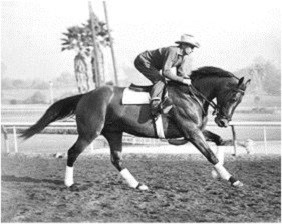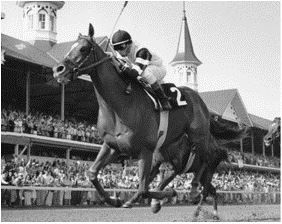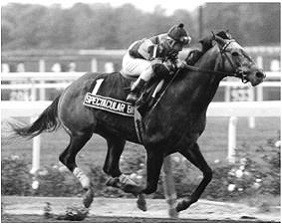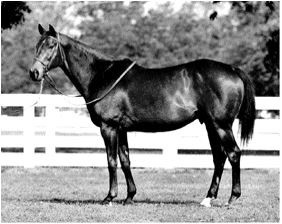
Photo: Native Dancer (center) in the saddling paddock being walked before the 1953 Dwyer Stakes at Aqueduct. (Stanley Morgan Collection – Keeneland Library)
By: Walter Lazary /// January, 2024
America’s Best Horses Overall in the 20th Century
When perusing through various listings of the top ten racehorses of the twentieth century, and I mean a dozen or so others that you will find on the internet, there is no doubt that in just about every one of them, either Man o’ War or Secretariat was considered the best American thoroughbred racehorse in that one-hundred-year period with probably most rating Man o’ War above Secretariat. There is no doubt that you could put forth a compelling argument in support of either one. However, after pouring through reams of information and comparing specific criteria, there is another colt that should also be strongly considered best and that is Calumet Farm’s Citation.
Man o' War
There is no doubt that Man o’ War was the dominant racehorse of his era, but looking back, you can also poke a few holes in his impeccable record. My greatest concern was the overall quality of the opposition that he ran against, and this concern could also be supported by the relatively low foal crop sizes that were prevalent in those years. In his great three-year-old campaign in which he won all eleven of his starts, we must remember that in six of those starts he faced but a single opponent, and in three others he faced only two. In fact, during that year he faced a total of 23 horses, and eight of those were in his first race, the Preakness Stakes.
Man o’ War’s career was bordered by some of America’s greatest horses, the likes of Colin, Sysonby, Fitz Herbert, Whisk Broom II, Regret, Roamer, and Old Rosebud, all of whom raced before his time, and Cudgel, Exterminator, Grey Lag, Zev, Sarazen, Gallant Fox, Equipoise, and Twenty Grand, all of whom, with the exception of Exterminator, having raced after his retirement. We must also remember that Man o’ War never faced any of these nor the likes of them. It’s true that he humbled the great Sir Barton in the Gold Cup, but that was not Sir Barton at his best. The son of Star Shoot was hampered throughout his career by thin-walled hooves and the track surface at Kenilworth Park, when the two faced each other, had been scraped down the night before literally removing the cushion and leaving its surface extremely hard, this unfortunate undertaking because the race organizers wanted the winner to set a new world record. Every step Sir Barton took that day was labored, and therefore, it is safe to say that Man o’ War never faced Sir Barton when the first Triple Crown winner was at his best, though even if he did, there is little evidence that the result would have been different. In hindsight, however, we’ll never know.
We must also remember that Man o’ War’s owner, Samuel Riddle, refused to accept a challenge to run against Exterminator in a race longer than ten furlongs, though in fairness, Exterminator’s connections backed out of the Gold Cup because they considered the ten-furlong distance too short for their long-range specialist.
Man o’ War suffered his only career loss to Harry Payne Whitney’s Upset when he was a two-year-old. The race was the Sanford Memorial Stakes at Saratoga, and unfortunately he didn’t get a fair start. Still, he had every chance to win that race if his jockey, Johnny Loftus, didn’t steer him into trouble, not once, but twice. But for a less than stellar ride from a jockey, who at the time was considered among America’s best, Man o’ War would have had an undefeated career as his only other difficult race was when he was pushed to the limit by John P. Grier in the 1920 Dwyer Stakes, which he won by a length and a half. We must also remember that Man o’ War handily defeated John P. Grier the two other times they met, in the Futurity and the Travers.
Secretariat
Now, let’s look at Secretariat’s five career losses and see how he also could possibly have had an undefeated career.
(1) His first loss was when he was interfered with and solidly bumped in his first race, a Maiden Special Weight (MSW). When he recovered, he was about eight lengths off the lead, then finished a fast-closing fourth, losing by a little more than a length to Herbull with Master Achiever finishing second by a neck. In Secretariat’s next start, another MSW, he defeated Master Achiever by six lengths.
(2) When Secretariat suffered his second career loss in the Champagne Stakes, he actually finished first by two lengths but was disqualified and placed second to Stop the Music, a colt he defeated by 1¾ quarter lengths when both met in the Belmont Futurity the previous month. In Secretariat’s next race following the Champagne, the Laurel Futurity, he dominated Stop the Music and won by eight lengths.
(3) After Secretariat finished third in the Wood Memorial to his stablemate Angle Light, with Sham finishing second, it was discovered that he had an abscess on his gum and it was aggravated by the bit, which might account for his lackluster performance and the fact that he was hard to control on the far turn when he went wide. He was much better than Angle Light, whom he defeated by 16 lengths in the Laurel Futurity and by more than 20 lengths in the Kentucky Derby, and it is well-documented how he destroyed Sham in the three Triple Crown races. (Note: There have been contradicting remarks about the abscess. Some say that trainer Lucien Lauren knew that he had it and still allowed him to run, while others stated that he didn’t know about it until after the race. In any event, it is a fact that Secretariat ran with the abscess, and it obviously affected his performance.)
(4) Secretariat’s loss in the Whitney Stakes to Onion, a horse that would win just a single stake in a career that saw him go to the post 54 times, was blamed on a fever. The fever really did affect his performance and was more than likely responsible for his lethargic preparations leading up to what was his first race against older horses. The fever weakened him, turning him into a shell of the horse that won the Triple Crown, and it lingered on for several days after the Whitney causing him to miss his main summer objective, the Travers Stakes. When Secretariat and Onion met in the Marlboro Invitation six weeks later, a race that also included Riva Ridge, Cougar II, the Hollywood Gold Cup winner Kennedy Road, Key to the Mint, and the 1973 Travers winner Annihilate ‘Em, he not only set a world record for nine-furlongs (1:45 2/5), but in doing so he defeated Onion by 12 lengths.
(5) This leads to Secretariat’s fifth and final career loss, this time to Onion’s stablemate Prove Out in the Woodward Stakes. Riva Ridge was originally scheduled to run in the Woodward while Secretariat was going to bypass it and compete on turf for the first time nine days later in the Man o’ War Stakes. When Belmont Park’s main track was rated as being extremely sloppy for the Woodward (a track condition in which Riva Ridge finished fourth to Key to the Mint the year before in the Preakness Stakes when he was the 7-5 favorite), Lucien Lauren decided to scratch the son of First Landing. The colt hated the slop, and it is widely believed that he lost the Preakness when he was unable to handle Pimlico’s extremely sloppy surface. Sputtering from the break, Riva Ridge suffered a devastating defeat as the odds-on 3 to 10 favorite, one which ultimately cost him a legitimate shot at the Triple Crown as he won the Belmont by seven lengths three weeks later.
Early on the morning of the Woodward, Mrs. Tweedy, not wishing to disappoint the thousands of fans that she knew would make their way out to Belmont Park to see Riva Ridge, ordered trainer Lucien Lauren to enter Secretariat as his stablemate’s replacement (Big Red had already been cross-entered as a formality). The problem was that Secretariat was not adequately prepared to run a mile and one-half, and in order for him to run his best, Laurin knew that he needed one more workout. It was well-documented that Secretariat needed a good hard workout before running in a race to be at his best. This, plus the fact that he ran his eyeballs out two weeks before when setting the world record in the Marlboro Invitation, perhaps had something to do with his running out of gas and being caught by Prove Out in the mile and one-half stake. Prove Out, who would win the two-mile Jockey Club Gold Cup the following month, ran possibly the second-fastest twelve-furlong race ever on dirt, 2:25 4/5. It is important to note that Secretariat’s second-place time of 2:26 3/5 was faster than all but five Belmonts in that storied race’s history.
And so, if Secretariat would have been 100% and turned the table in all those losses, a thought that is not inconceivable, he could have been undefeated through his three-year-old season. Which also makes it worthy to review Citation’s career.
Citation
When Citation completed his three-year-old season, he had run 29 times and won 27 with two-second place finishes. Once again, we are faced with another “what could have been” scenario as we’re looking at a horse who could easily have won all of those 29 starts.
Citation’s first career loss was to his stablemate, the two-year-old filly Bewitch, in the Washington Futurity. In that race trainer, trainer Jimmy Jones saddled a three-horse entry as Free America joined America’s top two-year-old colt and filly. It has been stated many times that Jones told the jockeys before the race (they had already agreed to split all purse money) that if a Calumet horse was leading when they turned into the stretch and if there was no threat from another horse, then that Calumet horse should be allowed to win the race. As the race unfolded, Bewitch was leading coming off the far turn while Citation, who was as many as six lengths back, was making a big move that took him from fourth to second place. Still full of run when he turned into the stretch, jockey Steve Brooks had to pull Citation and let Bewitch win as the big son of Bull Lea was poised to blow right by her. When they next met in the Belmont Futurity, Citation easily defeated Bewitch, who would later be crowned the two-year-old champion filly, by three lengths.
Citation’s second career loss is even more difficult to accept. In the Chesapeake Stakes prep at Havre de Grace, a colt named Saggy had a length and a half lead on Citation nearing the top of the stretch, at which point Cy was carried very wide by a colt named Hefty, who would finish last and whose jockey would later draw the ire of the stewards. Eddie Arcaro, in his first career ride on Citation, openly admitted after the race that if he wanted to, he could have won that race, but he was saving Citation for the Chesapeake Stakes itself and its much greater purse money. The race before the Chesapeake prep was the Flamingo Stakes, which Citation won while Saggy finished third, ten lengths behind. When they faced each other in the Chesapeake Stakes, Citation was an easy winner while Saggy finished fifteen lengths behind and did not make the top three. Thus, Eddie Arcaro, not realizing the significance of this race because he was trying to think ahead and didn’t realize the effect it would have in the bigger picture of this great horse’s career, contributed to a loss that, despite his previous loss to Bewitch, could have led to a 24-race unbeaten streak.
There are several other compelling reasons why Citation could easily have been considered the best horse of the 20th century, among them defeating the reigning Horse of the Year, Armed, twice in February of his three-year-old season (while technically still a two-year-old). Citation also faced older horses eight times that year and won them all.
And so, when looking at the individual careers of Man o’ War, Secretariat, and Citation, if we considered just their two and three-year-old seasons (neither Man o’ War nor Secretariat raced at four), you could make a strong argument for a three-way tie for the best racehorse of the twentieth century. Unfortunately for Citation, this greatest of all Calumet stars came back to the races after a leg injury kept him away for thirteen months and was never quite the same, which was enough for me to place him third. However, after reading his profile page, you might think differently and put him at the top of the heap.
In the end, both Man o’ War and Secretariat were my top choices, but after considering everything, I really couldn’t find a reason to place one ahead of the other, so I did the next best thing and called it a tie.
Below, are photos of each of HorseRacing20thCentury99.com’s top ten American racehorses that competed in the twentieth century. Tap ON EACH to go to their profile pages.
Best 11 through 20
Tap on image for slide presentation in LIGHTBOX:




















